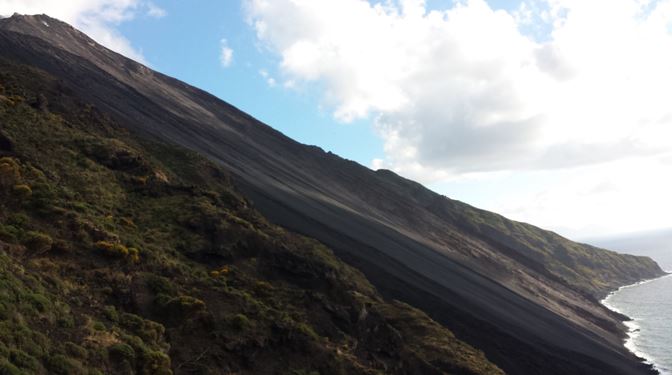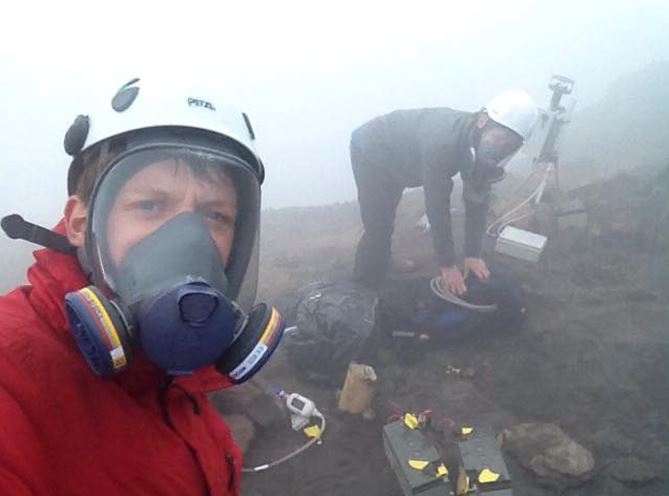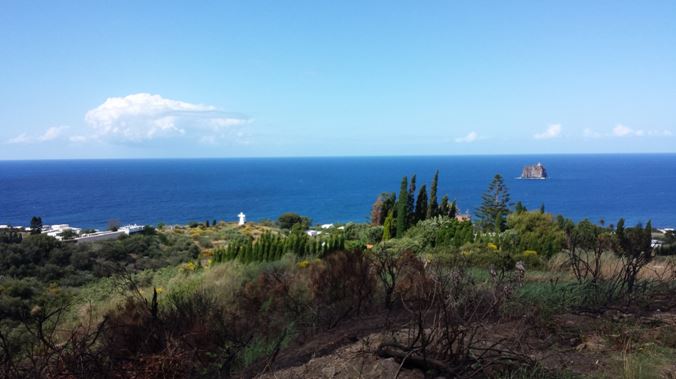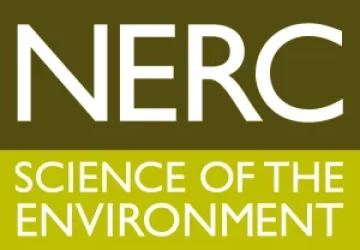Hi, I’m Nahum. I’m in my first year of my PhD looking at methods of measuring volcanic gases. Recently I went on fieldwork to Stromboli volcano. Stromboli is one of the eight Aeolian Islands, which form an arc just off the northern coast of Sicily, Italy. It’s one of the most famous active volcanoes in the world, consistently showing some form of activity for the last 2000 years. The volcano is most well-known for regular explosions at the summit which send fragments of molten rock known as volcanic bombs high up into the air. The explosions are a major tourist attraction; people pay to be taken up the volcano to watch them, normally at night so they can see the glow from the bombs. Tourist websites claim that explosions happen every 15 minutes on average, but every 30 minutes is probably more realistic.

As well as being one of the most famous volcanoes, Stromboli is also one of the most studied. It is permanently monitored by Italian scientists who record any earthquakes on the island as well as maintaining thermal cameras and measuring the gases given off. The constant activity and easy access also make it a favourite for scientists around the world. Despite this, there is still no consensus on what causes the regular explosions that make the volcano so popular.
There are two main theories both of which rely on large gas bubbles known as slugs rising up and exploding when they reach the surface. The ideas disagree on where the gas bubbles merge to form the large slugs; one idea has the bubbles merge into an ever larger slug as they rise up through the conduit whilst the other has bubbles exsolving in a chamber below the conduit and accumulating at the top of the chamber in what is called a foam layer. This layer is unstable and can collapse, releasing large amounts of gas which rise as the slug. To try to better understand what causes the explosions, we went to Stromboli to measure the compositions of the gases that are released, whilst colleagues from Italy and America were recording the explosions with high speed cameras.

We measure the gases that were emitted with two main methods. The first uses chemical reactions with electrolytes to produce a voltage which can be measured and recorded, the idea being that the voltage is then proportional to the concentration of the gas present and can show how they were changing over time. By using calibration experiments we can then determine this concentration. The second method we used was to trap the gas on filter papers soaked in a basic solution. The gases are acidic and once trapped can be taken back to the labs in Cambridge where we’ll be analysing them over the next few months. This method isn’t able to give us a time series of how the concentrations were changing, but it can give information about the levels of trace metals and the presence of a much wider number of gases than the electrochemical sensors can.
A typical day had us starting the trek up to the summit sometime after 8.30 in the morning. It took us about 3 hours each day to reach the summit so the (relatively) early start meant that we’d be on the summit with enough time to work through the day and had the added benefit that we climbed up to the higher slopes where the wind helped to keep us cool before the midday temperatures really started to kick in. Even so, a three hour hike with up to 30 kilos of equipment on your back really does take it out of you! Once at the summit our first job was always to collect the data that our electrochemical sensors had logged onto USB sticks over the previous night. As soon as the data was backed up our priority was to site the sensors somewhere they were likely to be able to ‘see’ the plume. For them to work, they have to be able to sample the plume directly, i.e. they have to sit right in the middle of it and this meant that we would play a guessing game over where the wind would be blowing the plume for the next 24 hours.

The filter papers also have to sit in the plume and air needs to be pumped through them so as much gas as possible is sampled. We’d prepare the filtering equipment the night before, carrying it up to the summit with us in the morning and then set it out for periods of roughly an hour; any longer and they can start to saturate. While we were waiting we’d be making notes of the behaviour the volcano was showing at the time. When you are stood in the plume, visibility is maybe 50m at best so you can’t see the explosions directly, but you hear them instead. The best way I can describe is like a jet engine, with a roaring lasting around 10 seconds, after which you can make out a spattering sound as the bombs hit the ground again. Very occasionally some of the ash and smaller particles would land around us. After the filter papers were finished we’d check the wind direction again, move anything that needed it and begin the long walk back down the mountain to prep for the next day.

Fieldwork is always tough, you want to try and collect as much data as possible whilst you can so the days are long and physically challenging. That said, it’s an amazing experience, travelling to incredible parts of the world is one of the absolute best parts of my PhD. Stromboli especially had some fantastic highlights; we met great people, at the end of each day ate great food (along with great wine) – and hopefully we’ll have great results!


